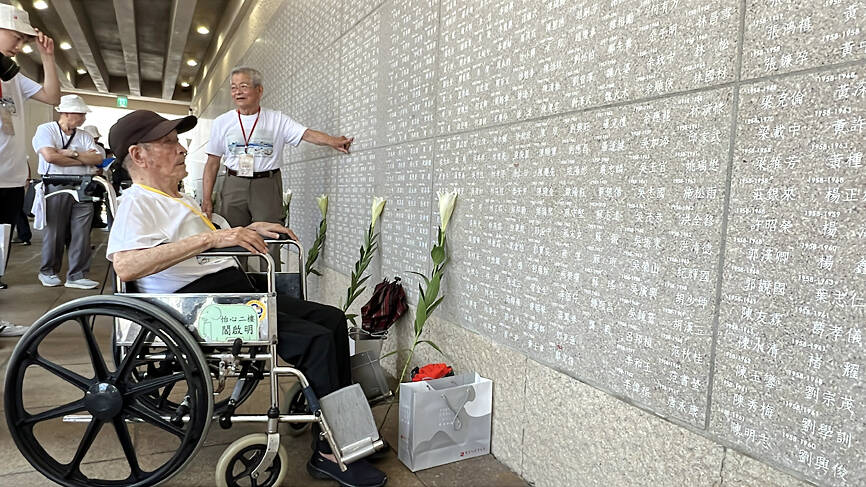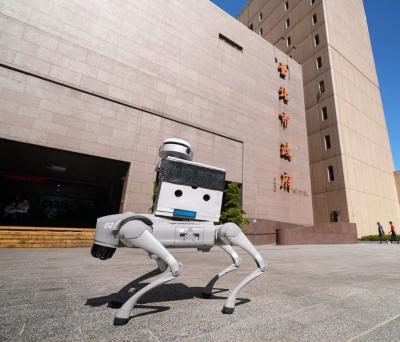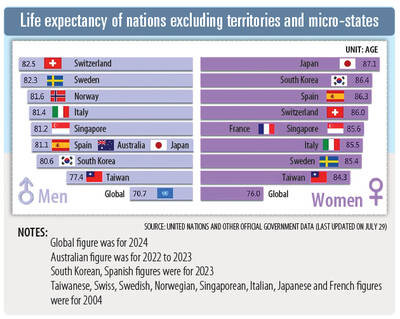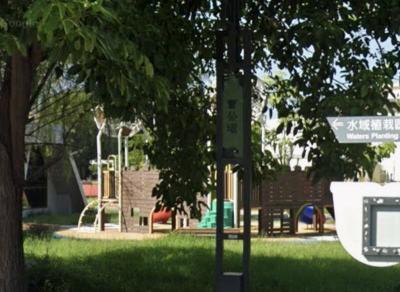After the first group of political prisoners was sent to Green Island (綠島) in May 1951, several thousand more followed over the next three decades, incarcerated on a small outpost off southeast Taiwan.
Much like those facing the White Terror on Taiwan proper, inmates held at the island’s New Life Correction Center — and later the Oasis Villa — endured torture and forced labor, on top of harsh and austere living conditions shaped by the island’s natural limitations.
The prison compound on the 15km2 outcrop overlooking the Pacific was a grim and isolated existence, despite the hopeful terms such as “oasis” and “new life.”

Photo: CNA
The physical and psychological toll political prisoners endured is a central theme of the Green Island Biennial, held at what has since 2018 been transformed into a memorial park.
The geographically imposed punishment was not unique to Green Island.
Throughout modern history, it has remained a tool of authoritarian control, banishing people to the margins of society, yet keeping them close enough to serve as a stark warning to others.
This year’s exhibition, which started on May 17 and ends on Sept. 21, looks beyond Taiwan to explore other sites of exile and their scarred histories as seen through the eyes of artists from Taiwan and abroad, chief curator Nobuo Takamori said.
Croatian artist Andreja Kuluncic’s installation project You Betrayed the Party Just When You Should Have Helped It focuses on the deserted island of Goli Otok (literally “Naked Island” in English), which was home to a detention camp when Croatia was a part of Yugoslavia.
More than 800 women were detained on Goli Otok, accused by then-Yugoslavian president Josip Broz Tito’s regime of having ties to Soviet-aligned factions, around the same time political prisoners were sent to Green Island in the 1950s.
Kuluncic’s extensive research sheds light on the brutal treatment of women held on Goli Otok, including being forced to haul stones up and down hills repeatedly with no practical purpose — a punitive exercise designed to wear them down physically and mentally.
Such experiences mirrored those of Green Island’s prisoners, who were ordered to collect coral stones to build their own confinement.
Through videos and images, Kuluncic rekindles long-silenced conversations about the female prisoners on Goli Otok, where the dilapidated settlement remains a testament to their suffering and traumatic memories.
Peripheral islands once used to imprison political dissidents continue to carry the imprint of suffering long after the prisoners have left — a lingering presence that has fascinated Taiwanese artist Liu Yun-yi (劉芸怡).
In her installation project, Island Lexicon: Mapping Possible Paths for the Return of Absent Memories (島嶼辭典:為缺席的記憶描繪重新抵達的可能路), Liu blends the landscapes of Green Island and Vietnam’s Con Son Island, where Con Dao Prison was located, juxtaposing prison ruins and artificially altered terrain to evoke the haunting pasts of both islands and their transformation over time.
The blurred boundary between the two sites is intentional: They are so intertwined in Liu’s images and sculptures that viewers can hardly distinguish which island they are seeing.
Both islands are now popular tourist destinations, known for their natural beauty and water activities.
Green Island welcomes about 40,000 visitors each month during the peak season — 10 times its resident population — and many, clad in diving gear or riding in scooter convoys, casually pass the former prison compound under the blazing sun.
Yet underneath the scenic allure, and despite preservation efforts at the memorial park, the prison cells remained steeped in desolation and their eeriness intact even under daylight.
The Con Dao Prison — where people deemed threats by French colonizers were imprisoned and tortured from as early as 1861 and well into the 20th century — is even more bleak, Liu said.
The infamous “tiger cages,” built by the French and later used by the Western-backed South Vietnamese government to cram political prisoners into tiny cells, remain a chilling reminder of what many have described as “hell on Earth.”
Just off Hong Kong’s nortwest coast lies another Green Island (青洲), known as Tsing Chau in Cantonese.
Hong Konger Michelle Lee (李可穎) draws on the island’s history in her video installation project, A Cold Wind Blows, to echo Taiwan’s Green Island, exploring the displacement and solitude of those once held on the islands.
For two decades, starting in the 1970s, Hong Kong’s Green Island sheltered Vietnamese refugees fleeing their home country by boat for economic and political reasons in open and later closed camps.
In one of the small, wooden-floored cells at the Oasis Villa repurposed as an exhibition space for the biennial, Lee constructed a skeletal boat frame embedded with objects, such as a hose clamp that inmates on Taiwan’s Green Island would use to cut fruit from trees during the scorching summer heat.
The details speak to the resilience shown by Taiwanese political prisoners and Vietnamese refugees as they made do with little.
Such spirit can also be seen in Indonesian artist Angga Cipta’s Gempa Langit (Skyquake), a multimedia project centered on Indonesian writer Pramoedya Ananta Toer and Taiwanese painter and photographer Ou Yang-wen (歐陽文), both of whom continued to create in defiance of their decade-long imprisonment.
For Takamori, featuring international art in the exhibition is about building bridges between local history and global human rights discourse.
Such cross-border connections also help narrate the history of the White Terror era — a period of political repression under the Chinese National Party’s (KMT) authoritarian rule from 1949 to 1987 — to foreign and domestic audiences.
“It appears we’re showing the story of another country, but in effect, it’s through their story that we tell our own,” Takamori said.
The exhibition is free to the public.

The inspection equipment and data transmission system for new robotic dogs that Taipei is planning to use for sidewalk patrols were developed by a Taiwanese company, the city’s New Construction Office said today, dismissing concerns that the China-made robots could pose a security risk. The city is bringing in smart robotic dogs to help with sidewalk inspections, Taipei Deputy Mayor Lee Ssu-chuan (李四川) said on Facebook. Equipped with a panoramic surveillance system, the robots would be able to automatically flag problems and easily navigate narrow sidewalks, making inspections faster and more accurate, Lee said. By collecting more accurate data, they would help Taipei

STATS: Taiwan’s average life expectancy of 80.77 years was lower than that of Japan, Singapore and South Korea, but higher than in China, Malaysia and Indonesia Taiwan’s average life expectancy last year increased to 80.77 years, but was still not back to its pre-COVID-19 pandemic peak of 81.32 years in 2020, the Ministry of the Interior said yesterday. The average life expectancy last year increased the 0.54 years from 2023, the ministry said in a statement. For men and women, the average life expectancy last year was 77.42 years and 84.30 years respectively, up 0.48 years and 0.56 years from the previous year. Taiwan’s average life expectancy peaked at 81.32 years in 2020, as the nation was relatively unaffected by the pandemic that year. The metric

TAKING STOCK: The USMC is rebuilding a once-abandoned airfield in Palau to support large-scale ground operations as China’s missile range grows, Naval News reported The US Marine Corps (USMC) is considering new sites for stockpiling equipment in the West Pacific to harden military supply chains and enhance mobility across the Indo-Pacific region, US-based Naval News reported on Saturday. The proposed sites in Palau — one of Taiwan’s diplomatic allies — and Australia would enable a “rapid standup of stored equipment within a year” of the program’s approval, the report said, citing documents published by the USMC last month. In Palau, the service is rebuilding a formerly abandoned World War II-era airfield and establishing ancillary structures to support large-scale ground operations “as China’s missile range and magazine

A 72-year-old man in Kaohsiung was sentenced to 40 days in jail after he was found having sex with a 67-year-old woman under a slide in a public park on Sunday afternoon. At 3pm on Sunday, a mother surnamed Liang (梁) was with her child at a neighborhood park when they found the man, surnamed Tsai (蔡), and woman, surnamed Huang (黃), underneath the slide. Liang took her child away from the scene, took photographs of the two and called the police, who arrived and arrested the couple. During questioning, Tsai told police that he had met Huang that day and offered to